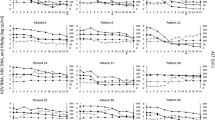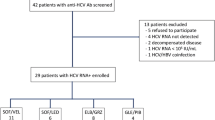Abstract
Nearly 200 million individuals worldwide are currently infected with hepatitis C virus (HCV)1. Combination therapy with pegylated interferon and ribavirin, the latest treatment for HCV infection, elicits long-term responses in only about 50% of patients treated2,3,4. No effective alternative treatments exist for non-responders5. Consequently, significant efforts are continuing to maximize response to combination therapy6,7. However, rational therapy optimization is precluded by the poor understanding of the mechanism(s) of ribavirin action against HCV8. Ribavirin alone induces either a transient early decline or no decrease in HCV viral load9,10,11,12, but in combination with interferon it significantly improves long-term response rates2,3,4,13,14,15. Here we present a model of HCV dynamics in which, on the basis of growing evidence16,17,18,19,20,21, we assume that ribavirin decreases HCV infectivity in an infected individual in a dose-dependent manner. The model quantitatively predicts long-term response rates to interferon monotherapy and combination therapy, fits observed patterns of HCV RNA decline in patients undergoing therapy, reconciles conflicting observations of the influence of ribavirin on HCV RNA decline, provides key insights into the mechanism of ribavirin action against HCV, and establishes a framework for rational therapy optimization.
This is a preview of subscription content, access via your institution
Access options
Subscribe to this journal
Receive 51 print issues and online access
$199.00 per year
only $3.90 per issue
Buy this article
- Purchase on Springer Link
- Instant access to full article PDF
Prices may be subject to local taxes which are calculated during checkout



Similar content being viewed by others
References
World Health Organization, Hepatitis C—global prevalence (update). World Health Org. Weekly Epidemiol. Rec. 75, 18–19 (2000)
National Institutes of Health. Consensus Statement on Management of Hepatitis C. NIH Consens. State Sci. Statements 19, 1–46 (2002)
Manns, M. P. et al. Peginterferon α-2b plus ribavirin compared with interferon α-2b plus ribavirin for initial treatment of chronic hepatitis C: a randomised trial. Lancet 358, 958–965 (2001)
Fried, M. W. et al. Peginterferon α-2a plus ribavirin for chronic hepatitis C virus infection. N. Engl. J. Med. 347, 975–982 (2002)
Tan, S.-L., Pause, A., Shi, Y. & Sonenberg, N. Hepatitis C therapeutics: Current status and emerging strategies. Nature Rev. Drug Discov. 1, 867–881 (2002)
Shiffman, M. L. et al. A randomized, controlled trial to determine whether continued ribavirin monotherapy in hepatitis C virus-infected patients who responded to interferon–ribavirin combination therapy will enhance sustained virologic response. J. Infect. Dis. 184, 405–409 (2001)
Hoofnagle, J. H. et al. Maintenance therapy with ribavirin in patients with chronic hepatitis C who fail to respond to combination therapy with interferon alpha and ribavirin. Hepatology 38, 66–74 (2003)
Lau, J. Y. N., Tam, R. C., Liang, T. J. & Hong, Z. Mechanism of action of ribavirin in the combination treatment of chronic HCV infection. Hepatology 35, 1002–1009 (2002)
Dusheiko, G. et al. Ribavirin treatment for patients with chronic hepatitis C: results of a placebo-controlled study. J. Hepatol. 25, 591–598 (1996)
Bodenheimer, H. C. et al. Tolerance and efficacy of oral ribavirin treatment of chronic hepatitis C: A multicenter trial. Hepatology 26, 473–477 (1997)
Zoulim, F. et al. Ribavirin monotherapy in patients with chronic hepatitis C: a retrospective study of 95 patients. J. Viral Hepat. 5, 193–198 (1998)
Pawlotsky, J.-M. et al. Antiviral action of ribavirin in chronic hepatitis C. Gastroenterology 126, 703–714 (2004)
McHutchison, J. G. et al. Interferon α-2b alone or in combination with ribavirin as initial treatment for chronic hepatitis C. N. Engl. J. Med. 339, 1485–1492 (1998)
Reichard, O. et al. Randomized, double-blind, placebo-controlled trial of interferon α-2b with and without ribavirin for chronic hepatitis C. Lancet 351, 83–87 (1998)
Poynard, T. et al. Randomized trial of interferon α2b plus ribavirin for 48 weeks or for 24 weeks versus interferon α2b plus placebo for 48 weeks for treatment of chronic infection with hepatitis C virus. Lancet 352, 1426–1432 (1998)
Lanford, R. E. et al. Antiviral effect and virus-host interactions in response to alpha interferon, gamma interferon, poly(I)-poly(C), tumor necrosis factor alpha, and ribavirin in hepatitis C virus subgenomic replicons. J. Virol. 77, 1092–1104 (2003)
Contreras, A. M., Viral, R. N. A. et al. mutations are region specific and increased by ribavirin in a full-length hepatitis C virus replication system. J. Virol. 76, 8505–8517 (2002)
Young, K.-C. et al. Identification of a ribavirin-resistant NS5B mutation of hepatitis C virus during ribavirin monotherapy. Hepatology 38, 869–878 (2003)
Lanford, R. E. et al. Ribavirin induces error-prone replication of GB virus B in primary tamarin hepatocytes. J. Virol. 75, 8074–8081 (2001)
Hong, Z. The role of ribavirin-induced mutagenesis in HCV therapy: A concept or a fact? Hepatology 38, 807–810 (2003)
Crotty, S., Cameron, C. E. & Andino, R. RNA virus error catastrophe: Direct molecular test by using ribavirin. Proc. Natl Acad. Sci. USA 98, 6895–6900 (2001)
Neumann, A. U. et al. Hepatitis C viral dynamics in vivo and the antiviral efficacy of interferon-α therapy. Science 282, 103–107 (1998)
Layden-Almer, J. E., Ribeiro, R. M., Wiley, T., Perelson, A. S. & Layden, T. J. Viral dynamics and response differences in HCV-infected African American and white patients treated with IFN and ribavirin. Hepatology 37, 1343–1350 (2003)
Herrmann, E., Lee, J.-H., Marison, G., Modi, M. & Zeuzem, S. Effect of ribavirin on hepatitis C viral kinetics in patients treated with pegylated interferon. Hepatology 37, 1351–1358 (2003)
Glue, P. The clinical pharmacology of ribavirin. Semin. Liv. Dis. 19, 17–24 (1999)
Steindl-Munda, P. et al. in Abstracts 11th Int. Symp. Viral Hepatitis and Liver Dis. 75–76 (2003).
Tsuboto, A. et al. Viral dynamics and pharmacokinetics in combined interferon α-2b and ribavirin therapy for patients infected with hepatitis C virus of genotype 1b and high pretreatment viral load. Intervirology 45, 33–42 (2002)
Neumann, A. U. et al. Differences in viral dynamics between genotypes 1 and 2 of hepatitis C virus. J. Infect. Dis. 182, 28–35 (2000)
McHutchison, J. G. et al. The impact of interferon plus ribavirin on response to therapy in black patients with chronic hepatitis C. Gastroenterology 119, 1317–1323 (2000)
Powers, K. A. et al. Modeling viral and drug kinetics: hepatitis C virus treatment with pegylated interferon α-2b. Semin. Liv. Dis. 23, 13–18 (2003)
Acknowledgements
We thank R. M. Ribeiro, J.-M. Pawlotsky, S. Zeuzem, X. Tong and B. Malcolm for helpful comments. Portions of this work were performed under the auspices of the US Department of Energy and supported by grants from the NIH, the University of Illinois and the Chicago VA.
Author information
Authors and Affiliations
Corresponding author
Ethics declarations
Competing interests
The authors declare that they have no competing financial interests.
Supplementary information
Supplementary Notes
Contains Supplementary Notes S1–S5, additional comments on the text. (DOC 25 kb)
Supplementary Tables S1–S3
Supplementary Table 1: Best-fit parameter estimates obtained from comparisons of model predictions with experimental viral load data from 17 patients who were given high dose daily interferon along with 1000 or 1200 mg ribavirin daily for the first 28 days of therapy; Supplementary Table 2: Model calculations of end-of-treatment (ETR) and sustained virological responses (SVR) for different initial viral loads, V0, interferon effectiveness, ε, and durations of treatment (24 or 48 weeks), with and without ribavirin; Supplementary Table 3: Estimates of ETR and SVR values as percentages of patients who completed therapy in various studies. (DOC 154 kb)
Supplementary Figure S1
Contains Supplementary Figure S1 and legends. (DOC 1041 kb)
Rights and permissions
About this article
Cite this article
Dixit, N., Layden-Almer, J., Layden, T. et al. Modelling how ribavirin improves interferon response rates in hepatitis C virus infection. Nature 432, 922–924 (2004). https://doi.org/10.1038/nature03153
Received:
Accepted:
Issue Date:
DOI: https://doi.org/10.1038/nature03153
This article is cited by
-
Stability of a diffusive-delayed HCV infection model with general cell-to-cell incidence function incorporating immune response and cell proliferation
Theory in Biosciences (2023)
-
Dynamics of a nonlocal viral infection model with spatial heterogeneity and general incidence
Journal of Evolution Equations (2023)
-
Response guided therapy for reducing duration of direct acting antivirals in chronic hepatitis C infected patients: a Pilot study
Scientific Reports (2020)
-
Hopf Bifurcation and Stability Switches Induced by Humoral Immune Delay in Hepatitis C
Indian Journal of Pure and Applied Mathematics (2020)
-
Mathematical Analysis of a Transformed ODE from a PDE Multiscale Model of Hepatitis C Virus Infection
Bulletin of Mathematical Biology (2019)
Comments
By submitting a comment you agree to abide by our Terms and Community Guidelines. If you find something abusive or that does not comply with our terms or guidelines please flag it as inappropriate.



